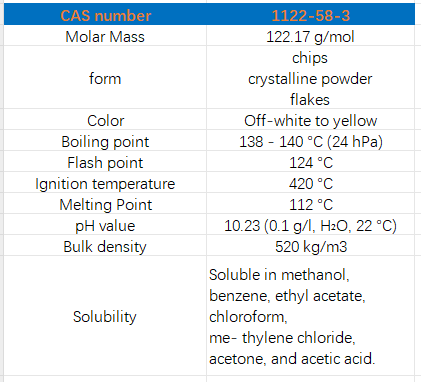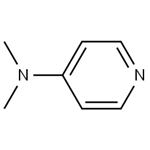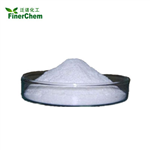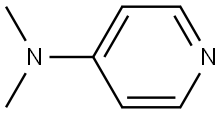Review and related research on 4-Dimethylaminopyridine
Mar 4,2024
Properties of 4-Dimethylaminopyridine
The physicochemical properties of 4-Dimethylaminopyridine are shown below:

Application of 4-Dimethylaminopyridine
4-Dimethylaminopyridine is a highly versatile nucleophilic catalyst for acylation reactions and esterifications. It is also employed in various organic transformations like Baylis-Hillman reaction, Dakin-West reaction, protection of amines, C-acylations, silylations, applications in natural products chemistry, and many others.
Related research on 4-Dimethylaminopyridine
Structural, physico-chemical analyses, Hirshfeld surface, and DFT calculations of a mixed phosphate-based compound templated by 4-dimethylaminopyridine (C7H11N2)2H2P2O7.H3PO4
Abstract Chemical preparation, crystallographic, thermal studies, and spectroscopic investigations are given for a mixed phosphate-based compound (C7H11N2)2H2P2O7.H3PO4 (I) with 4-dimethylaminopyridine cation (DMAP). Structurally, the single-crystal X-ray diffraction analysis revealed a three-dimensional herringbone arrangement assembled via intermolecular N-H···O and O-H···O H-bonding network. Latter non-covalent interactions were extensively described by Hirshfeld surface computational technique. Thermal stability was analyzed through TG-DTA and DSC experiments. Besides, solid-state NMR and IR spectroscopies confirm the X-ray study. In addition, theoretical calculations were performed using density functional theory. The relatively low calculated gap energy (0.33 eV) may be a sign of low compound stability and high polarizability behavior.
Probing into the Outcome of Charge Transfer Interactions and Hyperconjugative Effect on the Antibacterial Molecule 4-dimethylaminopyridine using Spectroscopic Elucidations and DFT Calculations
The prospective compound 4-dimethylaminopyridine was probed using FT-IR, FT-Raman, UV-Visible spectra and quantum chemical computations. Vibrational assignments pertaining to different modes of vibration with potential energy distribution have been augmented by normal coordinate analysis. Electronic stability of the compound arising from hyper conjugative interactions and charge delocalization is scrutinized using natural bond orbital analysis. The frontier molecular orbital energy gap probably indicates a compound's strong chemical reactivity and enables eventual charge transfer inside the molecule. The molecular electrostatic potential map and Fukui functions reveal that electronegative nitrogen and electropositive hydrogen atoms can be attacked by electrophiles and nucleophiles. The molecule's electron-hole distribution showed a charge transfer within the molecule, and the chemical implications of the molecule were described using electron localization function and localized orbital locator. Antibacterial activity of the compound with different bacterial strains was validated by agar well diffusion method. Ligand–protein interaction was explored by using molecular docking studies, while the pharmacokinetic aspects of the compound were probed using drug likeness and Absorption, Distribution, Metabolism, Excretion, and Toxicity properties.
Nine supramolecular adducts of 4-dimethylaminopyridine and organic acids constructed by classical H-Bonds and some noncovalent interactions
Cocrystallization of the commonly available 4-dimethylaminopyridine with a sets of acidic coformers gave a total of nine anhydrous and hydrous multicomponent adducts (4-dimethylaminopyridine): (2,4-dinitrobenzenesulfonic acid) [(HDMAP) · (dnbsa), dnbsa = 2,4-dinitrobenzenesulfonate] (1), (4-dimethylaminopyridine): (2-chloro-4-nitrophenol) [(HDMAP) · (cnpa), cnpa = 2-chloro-4-nitrophenolate] (2), (4-dimethylaminopyridine): (2,4,6-tribromophenol)2 [(HDMAP) · (tbp) · (Htbp), tbp = 2,4,6-tribromophenolate] (3), (4-dimethylaminopyridine): (4-chlorocinnamic acid)2: (H2O)3 [(HDMAP+)2 · (ccina−)2 · (H2O)3, ccina− = 4-chlorocinnamate] (4), (4-dimethylaminopyridine): (3,4,5-trimethoxycinnamic acid) [(HDMAP+) · (tmcina−), tmcina− = 3,4,5-trimethoxycinnamate] (5), (4-dimethylaminopyridine): (3,4-dichlorobenzoic acid): (H2O) [(HDMAP+) · (dcbza−) · (H2O), dcbza− = 3,4-dichlorobenzoate] (6), (4-dimethylaminopyridine): (2,5-dihydroxybenzoic acid) [(HDMAP) · (dhba), dhba = 2,5-dihydroxybenzoate] (7), (4-dimethylaminopyridine) (5-hydroxyisophthalic acid): [(HDMAP) · (Hipta), Hipta = hydrogen 5-hydroxyisophthalate] (8) and (4-dimethylaminopyridine): (tetrachlorophthalic acid) [(HDMAP) · (Htcpta), Htcpta = hydrogen tetrachlorophthalate] (9). The nine adducts have been characterized by XRD, IR and EA and the melting points of all adducts were also reported. Their structural and supramolecular facets are fully analyzed. The result reveals that all the studied crystals are organic salts with only the aryl N in DMAP protonated and the crystal packing is mediated via the strong N–H⋯O, N–H⋯S, N–H⋯Br, O–H⋯O and O–H⋯Br H-bonds from DMAP and the acidic bodies. Further analysis of the crystal piling of the salts told that a different series of additional CH–O/CH3–O, CH-π/CH3-π, CH3–CH, CH3–Cl, CH–Cl, CH3–Br, CH3–C, CH–C, CH–Br, C–C, O–O, O–C, O–N, O-π and π-π contacts helped the stabilization and expansion of the whole high-dimensional (1D-3D) packing. For the subtle balance of the various nonbonding associations these structures exhibited homo or hetero supramolecular synthons or both.
References:
[1] L. GUELMAMI; T. G; M Hajji. Structural, physico-chemical analyses, Hirshfeld surface, and DFT calculations of a mixed phosphate-based compound templated by 4-dimethylaminopyridine (C7H11N2)2H2P2O7.H3PO4[J]. Molecular Crystals and Liquid Crystals, 2023. DOI:10.1080/15421406.2023.2194570.
[2] J.D. DEEPHLIN TARIKA . Probing into the Outcome of Charge Transfer Interactions and Hyperconjugative Effect on the Antibacterial Molecule 4-dimethylaminopyridine using Spectroscopic Elucidations and DFT Calculations[J]. Journal of Molecular Structure, 2022. DOI:10.1016/j.molstruc.2021.132059.
[3] WEI FANG . Nine supramolecular adducts of 4-dimethylaminopyridine and organic acids constructed by classical H-Bonds and some noncovalent interactions[J]. Journal of Molecular Structure, 2020. DOI:10.1016/j.molstruc.2019.127321.
- Related articles
- Related Qustion
- 4-Dimethylaminopyridine: An Effective Acyl Transfer Agent Apr 14, 2023
4-Dimethylaminopyridine is a derivative of pyridine with the chemical formula (CH3)2NC5H4N.
- What is 4-Dimethylaminopyridine? Jun 30, 2020
What is 4-Dimethylaminopyridine?
Supplementation with pyridoxal 5'-phosphate monohydrate can synthesize neurotransmitters such as dopamine and serotonin, maintaining a healthy nervous system.....
Nov 4,2025Biochemical EngineeringRubber is an elastic substance obtained from the exudations of certain tropical plants (natural rubber) or derived from petroleum and natural gas.....
Mar 4,2024Catalyst and Auxiliary4-Dimethylaminopyridine
1122-58-3You may like
4-Dimethylaminopyridine manufacturers
- 4-Dimethylaminopyridine(DMAP)
-

- $0.00 / 1kg
- 2025-12-19
- CAS:1122-58-3
- Min. Order: 1kg
- Purity: 99%
- Supply Ability: 20MT
- 4-Dimethylaminopyridine
-

- 2025-12-19
- CAS:1122-58-3
- Min. Order:
- Purity: 0.99
- Supply Ability:
- 4-Dimethylaminopyridine
-

- $5.00 / 25kg
- 2025-12-18
- CAS:1122-58-3
- Min. Order: 1kg
- Purity: 99%
- Supply Ability: 100mt






